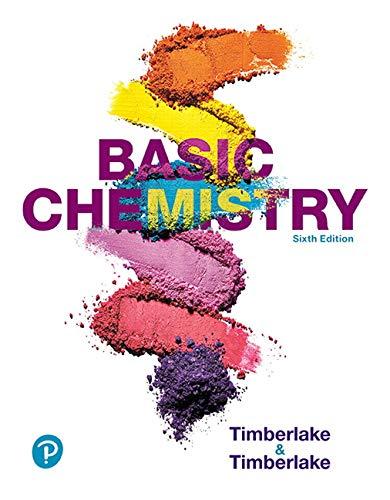
Concept explainers
(a)
Interpretation:
The name of an amino acid with the three-letter abbreviation Trpneeds to be identified.
Concept Introduction :
The amino acid consists of two
The three-letter abbreviation is generally done by taking first three letters from its name.
For example, the three letter and one letter abbreviations of some of the amino acids is as follows:
Arginine-Arg and R
Asparagine-Asn and N
Aspartic acid-Asp and D
(b)
Interpretation:
The name of an amino acid with the one-letter abbreviation M needs to be identified.
Concept Introduction :
The amino acid consists of two functional groups that is amino group as well as carboxylic acid group. There are 20 essential amino acids which are different from each other due to the different R group attached to the carbon containing amino as well as carboxyl groups. The amino acids can be named using the three and one-letter abbreviations.
The three-letter abbreviation is generally done by taking first three letters from its name.
For example, the three letter and one letter abbreviations of some of the amino acids is as follows:
Arginine-Arg and R
Asparagine-Asn and N
Aspartic acid-Asp and D
(c)
Interpretation:
The name of an amino acid with the three-letter abbreviation Pro needs to be identified.
Concept Introduction :
The amino acid consists of two functional groups that is amino group as well as carboxylic acid group. There are 20 essential amino acids which are different from each other due to the different R group attached to the carbon containing amino as well as carboxyl groups. The amino acids can be named using the three and one-letter abbreviations.
The three-letter abbreviation is generally done by taking first three letters from its name.
For example, the three letter and one letter abbreviations of some of the amino acids is as follows:
Arginine-Arg and R
Asparagine-Asn and N
Aspartic acid-Asp and D
(d)
Interpretation:
The name of an amino acid with the one-letter abbreviation G needs to be identified.
Concept Introduction :
The amino acid consists of two functional groups that is amino group as well as carboxylic acid group. There are 20 essential amino acids which are different from each other due to the different R group attached to the carbon containing amino as well as carboxyl groups. The amino acids can be named using the three and one-letter abbreviations.
The three-letter abbreviation is generally done by taking first three letters from its name.
For example, the three letter and one letter abbreviations of some of the amino acids is as follows:
Arginine-Arg and R
Asparagine-Asn and N
Aspartic acid-Asp and D
Want to see the full answer?
Check out a sample textbook solution
Chapter 18 Solutions
Basic Chemistry Plus Mastering Chemistry With Pearson Etext -- Access Card Package (6th Edition)
- At room temperature, amino acids are solids with relatively high decomposition points. Explain why.arrow_forwardWhich of the following is not a property of amino acidsa. Bufferb. Isoelectric pointc. Zwitterionsd. Insoluble in waterarrow_forwardof a protein. 15. The amino acid sequence is the a. primary structure b. secondary structure c. tertiary structure d. quaternary structure e. both secondary and tertiaryarrow_forward
- 26. Almost all proteins are composed from a set of about amino acids. 20 d. 50 a. 4 27. a. 5 b. 10 amino acids are considered essential. b. 10 C. C. 15 d. 20arrow_forwardThis amino acid belongs to a "basic amino acid" (at neutral pH). Molecule "A" COO™ I H₂N-C-H CH₂ Molecule "D" COO H₂N-C-H CH₂ H₂N O structure A O O structure B structure C structure D structure E structure F Molecule "B" COO™ + H₂N-C-H H-C-OH CH 3 Molecule "E" COO H₂N-C-H CH₂ C NH C-N CH Molecule "C" COO™ H₂N-C-H CH₂ OH Molecule "F" COO™ H₂N-C-H CH₂ | COO™arrow_forward34. Which of the following is not a property of amino acids a. Buffer 35. The protein primary structure is held together by a. Hydrogen bonds b. Isoelectric point C. Zwitterions d. Insoluble in water b. Disulfide bonds c. Peptide bonds d. Protein bondsarrow_forward
- give the name of three- letter abbreviation for the amino acid described by each of the following a. The non polar amino acid with a sulfur atom in its side chain b.A polar amino acid with a single nitrogen atom in its side chain c. The nonpolar amino acid with only one carbon in its side chainarrow_forward4. How is the following amino acid classified? H3Ñ-CHC-o CH2 a. nonpolar b. polar neutral c. polar acidic d. polar basicarrow_forwardExplain the differences in the litmus paper test results of the aqueous amino acid samples tested. a. alanine b. glutamic acid c. argininearrow_forward

 Introduction to General, Organic and BiochemistryChemistryISBN:9781285869759Author:Frederick A. Bettelheim, William H. Brown, Mary K. Campbell, Shawn O. Farrell, Omar TorresPublisher:Cengage LearningChemistry: Matter and ChangeChemistryISBN:9780078746376Author:Dinah Zike, Laurel Dingrando, Nicholas Hainen, Cheryl WistromPublisher:Glencoe/McGraw-Hill School Pub Co
Introduction to General, Organic and BiochemistryChemistryISBN:9781285869759Author:Frederick A. Bettelheim, William H. Brown, Mary K. Campbell, Shawn O. Farrell, Omar TorresPublisher:Cengage LearningChemistry: Matter and ChangeChemistryISBN:9780078746376Author:Dinah Zike, Laurel Dingrando, Nicholas Hainen, Cheryl WistromPublisher:Glencoe/McGraw-Hill School Pub Co Organic And Biological ChemistryChemistryISBN:9781305081079Author:STOKER, H. Stephen (howard Stephen)Publisher:Cengage Learning,
Organic And Biological ChemistryChemistryISBN:9781305081079Author:STOKER, H. Stephen (howard Stephen)Publisher:Cengage Learning, General, Organic, and Biological ChemistryChemistryISBN:9781285853918Author:H. Stephen StokerPublisher:Cengage Learning
General, Organic, and Biological ChemistryChemistryISBN:9781285853918Author:H. Stephen StokerPublisher:Cengage Learning Introductory Chemistry: A FoundationChemistryISBN:9781285199030Author:Steven S. Zumdahl, Donald J. DeCostePublisher:Cengage Learning
Introductory Chemistry: A FoundationChemistryISBN:9781285199030Author:Steven S. Zumdahl, Donald J. DeCostePublisher:Cengage Learning





